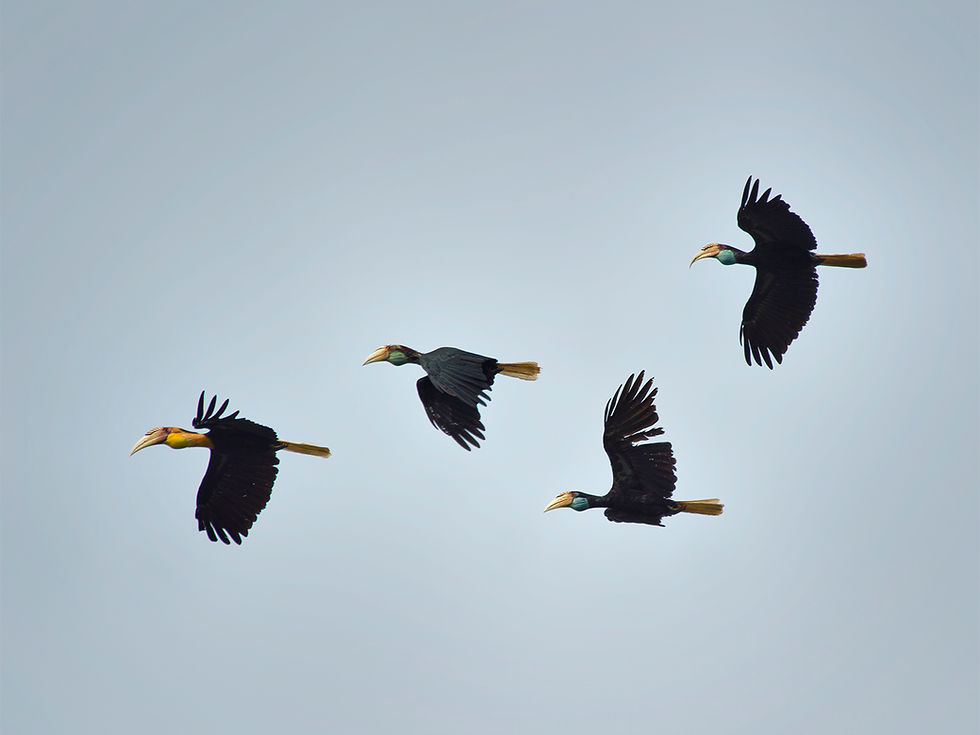General Characteristics of Hornbills
Hornbills are large, distinctive birds that play a crucial ecological role in Khao Sok National Park and Cheow Lan Lake. They are known for their large, curved bills, with female hornbills nesting inside tree cavities while the male provides food. Hornbills are vital to the forest ecosystem as they disperse seeds across the rainforest, helping to maintain biodiversity and the overall health of the forest.
Hornbill Species Found in Khao Sok and Cheow Lan Lake
Several species of hornbills can be found in Khao Sok and Cheow Lan Lake, including:
Rhinoceros Hornbill: A large bird with a bright orange-red bill and a distinctive casque.
Great Hornbill: The largest species, with black and white plumage and a yellow bill.
Bushy-crested Hornbill: Typically found in dense forests and often seen in groups.
Helmeted Hornbill: Noted for its large bill and casque, it has a unique call.
Ecological Role:Hornbills play a critical role in seed dispersal, as they consume large fruits and distribute the seeds over wide areas of the forest. This helps ensure the forest’s regeneration and supports the rich biodiversity in Khao Sok National Park, maintaining the health and diversity of the ecosystem.
Locations Where Hornbills Are Found in Cheow Lan Lake:Cheow Lan Lake is a key location for observing hornbills due to its dense tropical rainforests and towering limestone cliffs, which provide ideal habitats. Key areas to spot hornbills in Cheow Lan Lake include:
Islands and Forest Edges: Hornbills, particularly the Great and Rhinoceros Hornbills, are often seen perched on tall trees.
Khlong Saeng Mouth: Hornbills frequently forage for food here, especially in the mornings and evenings.
Three Brothers Rock: This scenic area is also a prime spot for spotting hornbills nesting in tall trees.
Limestone Forests Along the Lake: These forests provide large trees ideal for nesting, especially during the breeding season (November to March).

Hornbill Observation in Cheow Lan Lake:Longtail boat tours around Cheow Lan Lake offer an excellent opportunity to observe hornbills. Visitors can often spot hornbills flying over the water or perched in tall trees along the forested edges. Local guides with expertise in the area can enhance the experience by providing insights and increasing the chances of sightings.
Recommended Viewing Points:
Sichon Raft House and Pren Prai Raft House: Both locations offer excellent views of hornbills flying by.
Coral Bay: Surrounded by tall limestone cliffs and dense forests, this area is ideal for observing hornbills in their natural habitat.
Best Time to Observe Hornbills:The best time to see hornbills is during their feeding hours, early in the morning (6:00-9:00 AM) and late in the afternoon (4:00-6:00 PM). The breeding season from November to March is also ideal for observing hornbills as they are more active and easier to spot.
Cultural Significance:Hornbills also hold cultural importance in local communities, where they are seen as symbols of love and family. Their behavior, particularly the care they provide to their mates and offspring, represents stability and abundance.







